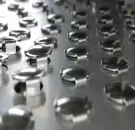Description/ Specification of Mass Transfer Process Design
Mass transfer process design is a critical facet of chemical engineering that involves the movement of mass from one place to another. This intricate field plays a pivotal role in various industries, including pharmaceuticals, petrochemicals, and environmental engineering, among others. Several key aspects contribute to the comprehensive understanding and effective implementation of mass transfer process design. Firstly, the selection of appropriate mass transfer equipment is fundamental. This includes an array of devices such as absorption towers, distillation columns, and extraction units, each tailored to specific process requirements. The choice of equipment depends on the properties of the substances involved, including their volatility, solubility, and chemical reactivity. Design considerations like surface area, flow rates, and packing materials directly impact the efficiency and effectiveness of the mass transfer process. Moreover, understanding the interplay between the operating conditions, material properties, and equipment specifications is crucial for optimizing the design and enhancing the overall process performance. Secondly, mass transfer process design necessitates a comprehensive understanding of fluid dynamics and heat transfer. An in-depth grasp of fluid flow patterns, pressure drops, and residence times is essential for maximizing mass transfer rates within the system. Integrating heat transfer considerations into the design process is vital as it impacts the energy requirements and influences the thermodynamic efficiency of the overall process. Balancing these factors while considering the potential impact on the environment and energy consumption is imperative in ensuring sustainable and cost-effective mass transfer processes. Thirdly, the incorporation of modern technologies such as computer-aided design (CAD) and computational fluid dynamics (CFD) has revolutionized the field of mass transfer process design. These tools facilitate the simulation of complex fluid flow and mass transfer phenomena, enabling engineers to visualize and optimize process parameters without the need for expensive and time-consuming physical experiments. Utilizing these technologies in the design phase enhances precision, reduces development time, and minimizes the risk of errors, thereby fostering innovation and improving the overall efficiency of mass transfer operations. Lastly, an integral part of mass transfer process design is the consideration of safety and environmental impacts. Implementing appropriate safety protocols, risk assessments, and environmental regulations is vital to prevent accidents and minimize the adverse effects of mass transfer operations on the ecosystem. Developing sustainable and environmentally friendly processes through the use of green solvents, waste minimization strategies, and efficient resource utilization is essential in aligning mass transfer process design with the principles of sustainable development and environmental conservation. In conclusion, an effective mass transfer process design requires a holistic approach that encompasses the selection of suitable equipment, a profound understanding of fluid dynamics and heat transfer, the integration of advanced technologies, and a strong focus on safety and environmental sustainability. By addressing these various aspects, engineers can develop efficient, cost-effective, and environmentally friendly mass transfer processes, thereby contributing to the advancement of multiple industries and the global pursuit of sustainable development.
Mass Transfer Process Design
Mass transfer process design is a critical facet of chemical engineering that involves the movement of mass from one place to another. This intricate field plays a pivotal role in various industries, including pharmaceuticals, petrochemicals, and environmental engineering, among others. Several key aspects contribute to the comprehensive understanding and effective implementation of mass transfer process design. Firstly, the selection of appropriate mass transfer equipment is fundamental. This includes an array of devices such as absorption towers, distillation columns, and extraction units, each tailored to specific process requirements. The choice of equipment depends on the properties of the substances involved, including their volatility, solubility, and chemical reactivity. Design considerations like surface area, flow rates, and packing materials directly impact the efficiency and effectiveness of the mass transfer process. Moreover, understanding the interplay between the operating conditions, material properties, and equipment specifications is crucial for optimizing the design and enhancing the overall process performance. Secondly, mass transfer process design necessitates a comprehensive understanding of fluid dynamics and heat transfer. An in-depth grasp of fluid flow patterns, pressure drops, and residence times is essential for maximizing mass transfer rates within the system. Integrating heat transfer considerations into the design process is vital as it impacts the energy requirements and influences the thermodynamic efficiency of the overall process. Balancing these factors while considering the potential impact on the environment and energy consumption is imperative in ensuring sustainable and cost-effective mass transfer processes. Thirdly, the incorporation of modern technologies such as computer-aided design (CAD) and computational fluid dynamics (CFD) has revolutionized the field of mass transfer process design. These tools facilitate the simulation of complex fluid flow and mass transfer phenomena, enabling engineers to visualize and optimize process parameters without the need for expensive and time-consuming physical experiments. Utilizing these technologies in the design phase enhances precision, reduces development time, and minimizes the risk of errors, thereby fostering innovation and improving the overall efficiency of mass transfer operations. Lastly, an integral part of mass transfer process design is the consideration of safety and environmental impacts. Implementing appropriate safety protocols, risk assessments, and environmental regulations is vital to prevent accidents and minimize the adverse effects of mass transfer operations on the ecosystem. Developing sustainable and environmentally friendly processes through the use of green solvents, waste minimization strategies, and efficient resource utilization is essential in aligning mass transfer process design with the principles of sustainable development and environmental conservation. In conclusion, an effective mass transfer process design requires a holistic approach that encompasses the selection of suitable equipment, a profound understanding of fluid dynamics and heat transfer, the integration of advanced technologies, and a strong focus on safety and environmental sustainability. By addressing these various aspects, engineers can develop efficient, cost-effective, and environmentally friendly mass transfer processes, thereby contributing to the advancement of multiple industries and the global pursuit of sustainable development.
